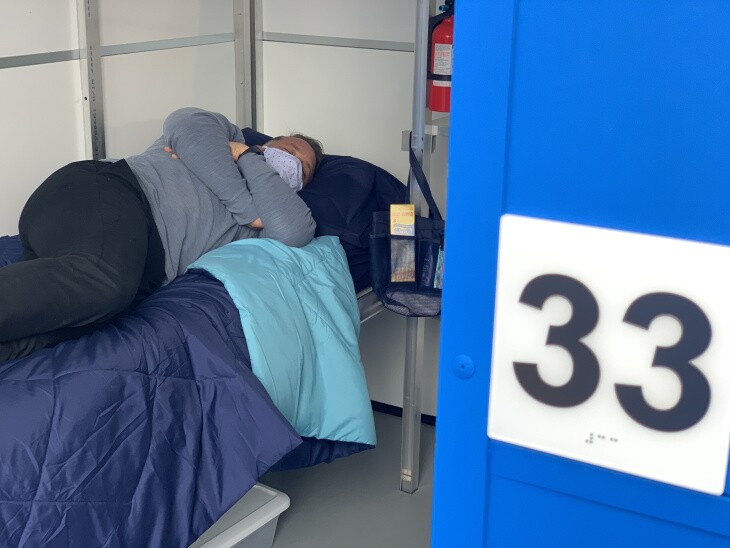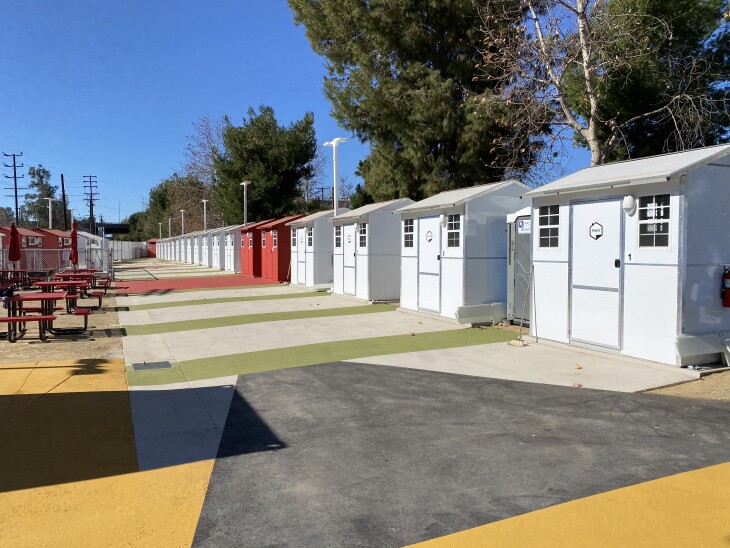Truth matters. Community matters. Your support makes both possible. LAist is one of the few places where news remains independent and free from political and corporate influence. Stand up for truth and for LAist. Make your year-end tax-deductible gift now.
First Tiny Home Community Opens In LA, With 75 Beds For Unhoused Angelenos

L.A. County's first "tiny home community" for people needing shelter welcomed its first residents on Monday.
The Chandler Street Tiny Home Village in North Hollywood was built, funded, and developed by the city of Los Angeles, in partnership with Councilman Paul Krekorian; its operated by a non-profit organization called Hope of the Valley.
The "village" has 40 homes and 75 beds. Each tiny home is 64-square-feet, with heating and air-conditioning, two beds, windows, a small desk, and a locking front door.
Ken Craft, Hope of the Valley founder and CEO, says the locking door is what sets the tiny home model apart from traditional shelters:
"It gives people a real sense of independence and security. To me, it allows all people -- but especially women -- to take a deep breath, regroup, and start living again, instead of just surviving."
Residents will also have access to onsite meals, WiFi, showers, mental health/housing support, job training/placement, and a small dog run.
The pallet shelter structures are made by a Seattle-based company. Craft says they are both inexpensive and easy to assemble. He says they're also a great fit for this kind of housing set-up because they're standalone structures, each placed six-feet apart, which allows some privacy and independence for residents.
UPDATE: There has been some sharp criticism of the overall cost of the project. As an L.A. Times editorial noted late last year:
"But it turns out, they’re not so cheap — at least not in Los Angeles, where a soon-to-open village of 39 tiny homes on an empty city lot in North Hollywood cost a stunning $5.2 million to set up. By contrast, the city of Riverside set up a village of 30 tiny homes last year for a total cost of about $514,000."

The two-bed set up allows couples to be together, or a parent and adult-child. (The community is only for adults.) Sometimes a parent needs to be with an adult child with special needs, for instance.
There's also an emphasis on security. The complex has video surveillance, a nine-foot fence surrounding the property, and a single, guarded entry point.
To qualify, individuals must be homeless and live within a three-mile radius of the site. The organization has an outreach and engagement team that's familiar with the area and the unhoused people who live there. They conduct interviews to determine vulnerability and need. "Then, based upon a numerical system that that we use in the homeless services world, that was developed by LHASA, we determine who's most vulnerable," Craft exlplains. The property is already full and has a waitlist.
Hope of the Valley also plans to open another tiny home village in North Hollywood, with 103 homes (200 beds total). The organization operates nine shelters in the area, each of them slightly different.
"We all know we need to get people off the street," says Craft, describing the homes as interim housing. The idea behind the project is to provide unhoused Angelenos with a safe, warm place to sleep, while the organization helps them find a more permanent solution through job training and other support.
If we're going to sit and wait until affordable housing is built, the homeless problem is going to keep growing. We have to be able to get people off the streets and get them into interim housing, while we're addressing the issue of affordable and permanent housing.
Case managers work with residents to prepare them for the job market — making sure they have a state-ID and social security card, figuring out how much income they need to afford a permanent home, and working around disabilities and immigration status. Craft says typically they are able to find permanent housing for residents within four-to-six months — although the coronavirus pandemic has made the process a bit longer.
"I believe in a housing-first model, where we would move everybody into a home and apartment, permanent housing," Craft explains. "The problem is that it's not available. And so in an area like Los Angeles, if we're going to sit and wait until affordable housing is built, the homeless problem is going to keep growing. We have to be able to get people off the streets and get them into interim housing, while we're addressing the issue of affordable and permanent housing."
Craft says that despite the passage of Measure HHH, there's been a lot of pushback against building affordable housing in some communities. Meanwhile, homlessness in L.A. is increasing. The tiny home community is meant to be a temporary solution to that much bigger, longterm problem.
"Homelessness last year increased by 13% in the county, and we've got one permanent supportive housing project open?," Craft says. "We just lost ground, and we are not getting people off the streets. So we need interim housing."
The rescue says it costs about $3,000 to build each tiny home (but note higher total costs, as reported by the L.A. Times above). Donors can donate to "sponsor" one via the organizations' website. Sponsor plaques with donor names appear on the exterior of each home.
Here's what the space looks like:






Corrected February 4, 2021 at 11:28 AM PST
A previous version of this story said the tiny home village was built by Hope of the Valley, in partnership with L.A. Councilman Paul Krekorian. The tiny home village was in fact built, funded and developed by the city of Los Angeles.
LAist regrets the error.







